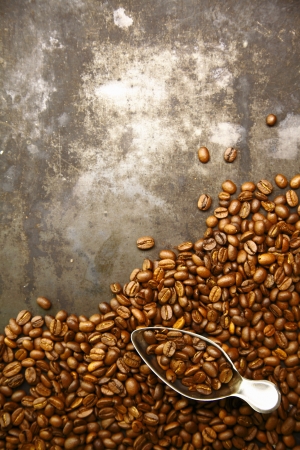1. The Environmental Impact of Coffee Waste
In the United States, coffee is more than just a morning ritual—its a daily necessity for millions. But with every cup brewed, used coffee grounds are left behind. These grounds often end up in the trash, contributing to a growing waste problem that’s rarely talked about.
How Big Is the Problem?
On average, Americans consume around 400 million cups of coffee per day. That adds up to over 146 billion cups a year! With each cup producing roughly 0.2 ounces of used coffee grounds, we’re looking at an estimated 1.8 million tons of coffee waste annually in the U.S. alone.
Where Does It All Go?
Most of these used coffee grounds end up in landfills, where they break down and release methane—a potent greenhouse gas thats over 25 times more effective than carbon dioxide at trapping heat in our atmosphere.
The Greenhouse Gas Effect
Methane emissions from decomposing organic materials like coffee grounds are a serious environmental concern. Heres how used coffee grounds stack up:
| Coffee Grounds Disposed (Annually) | Methane Emitted |
|---|---|
| 1.8 million tons | Approximately 340,000 metric tons of methane |
This amount of methane has the same climate impact as driving over 7 million passenger cars for a year. That’s a huge footprint for something most people don’t think twice about throwing away.
A Hidden Opportunity
The good news? Used coffee grounds don’t have to be waste. In fact, they hold surprising potential as an eco-friendly resource for everything from natural fertilizers to biofuels and even sustainable building materials. But before we dive into those solutions, it’s important to understand just how much of an environmental challenge we’re facing—and why finding better uses for our coffee leftovers matters more than ever.
2. Reimagining Spent Grounds: A New Resource
Most people think of used coffee grounds as just another item for the trash can. But what if we told you these leftovers from your morning brew could be turned into something useful—and even help the planet? That’s where upcycling comes in. Instead of discarding used coffee grounds, innovators are finding creative ways to give them a second life, turning waste into valuable, eco-friendly products. This process aligns with the concept of the circular economy, where nothing goes to waste and materials are continuously reused.
What Is Upcycling?
Upcycling is all about taking something that would normally be thrown away and transforming it into something better or more useful. Unlike recycling, which often breaks materials down into raw form, upcycling keeps most of the material intact, saving energy and reducing pollution.
Coffee Grounds: A Hidden Treasure
Used coffee grounds may seem like junk, but they’re actually full of potential. They contain nutrients, oils, and even absorbent properties that make them perfect for a variety of sustainable uses.
Common Upcycled Uses for Coffee Grounds
| Application | Description |
|---|---|
| Natural Fertilizer | Rich in nitrogen and other minerals that help plants grow. |
| Eco-Friendly Exfoliant | Used in soaps and scrubs for gentle skin exfoliation. |
| Odor Neutralizer | Placed in refrigerators or shoes to absorb bad smells. |
| Sustainable Textiles | Blended into fabrics to create fast-drying, odor-resistant clothing. |
| Bioplastics & Biofuels | Processed into renewable energy sources or biodegradable plastics. |
A Circular Economy Approach
The idea behind using spent coffee grounds this way fits perfectly within the circular economy model. Instead of following a linear path—make, use, dispose—we’re shifting toward a loop where materials are reused again and again. By rethinking waste as a resource, we reduce landfill contributions and support a more sustainable lifestyle.
Why It Matters
- Reduces overall waste going to landfills
- Cuts down on greenhouse gas emissions from decomposing organic matter
- Lowers demand for virgin materials by replacing them with repurposed ones
This new mindset not only helps businesses lower their environmental impact but also empowers everyday coffee lovers to take small steps toward sustainability—one cup at a time.
![]()
3. Eco-Friendly Applications of Coffee Grounds
Used coffee grounds aren’t just waste—they’re a valuable resource that can be repurposed into sustainable products. Across the U.S., eco-conscious individuals and businesses are finding creative ways to give coffee grounds a second life. Here are some practical and environmentally friendly applications:
Natural Fertilizers
Coffee grounds are rich in nitrogen, making them an excellent addition to compost or directly into garden soil. They help improve drainage, water retention, and aeration in the soil. Gardeners love using them to enrich their vegetable patches, flower beds, and even houseplants.
Benefits of Using Coffee Grounds in Gardening
| Application | Benefit |
|---|---|
| Composting | Adds nitrogen to compost mix |
| Soil amendment | Improves soil texture and moisture retention |
| Pest deterrent | Repels slugs and ants naturally |
Biodegradable Packaging
Startups and packaging companies across the U.S. are exploring the use of spent coffee grounds in creating biodegradable materials. These eco-friendly alternatives can replace single-use plastics in items like coffee cups, takeout containers, and more. The result? A lower carbon footprint and less plastic pollution.
Why Coffee-Based Packaging Matters
- Sustainable: Reduces reliance on petroleum-based plastics
- Compostable: Breaks down naturally in the environment
- Aesthetic: Has a natural look and earthy scent that appeals to eco-conscious consumers
Sustainable Skincare Products
The beauty industry is turning to upcycled coffee grounds for natural exfoliants in scrubs, soaps, and masks. Not only do these products reduce waste, but they also offer skin benefits like improved circulation and smoother texture. Many American brands proudly advertise their use of reclaimed coffee as part of their clean beauty mission.
Popular Skincare Uses for Coffee Grounds
| Product Type | Main Benefit |
|---|---|
| Body Scrub | Exfoliates dead skin cells naturally |
| Facial Mask | Tightens skin and reduces puffiness |
| Soap Bars | Cleanses while gently scrubbing the skin |
From backyard gardens to beauty shelves, used coffee grounds are proving they’re far from useless. By embracing these eco-friendly applications, we can all take part in brewing a more sustainable future—one cup at a time.
4. Brewing Business & Sustainability Together
Across the United States, more and more businesses are finding creative ways to turn used coffee grounds into sustainable solutions. From small local cafés to larger corporations, these initiatives show that going green can also make good business sense.
Local Cafés Leading the Way
Independent coffee shops are often at the forefront of eco-friendly practices. Many have partnered with community gardens or local farmers to donate used coffee grounds as compost material. Others repurpose grounds to make products like soaps or candles for sale in-store, adding a unique, eco-conscious touch to their brand.
Example: Café Grumpy (New York)
This popular NYC-based café chain collects its spent grounds and offers them free to customers for gardening. They also collaborate with local artists and makers who use the grounds in handmade goods.
Startups Turning Grounds into Gold
Startups across America are innovating with coffee waste, transforming it into high-value products such as biofuels, building materials, and skincare lines. These companies not only reduce landfill waste but also generate new revenue streams through sustainable production.
Innovative Startups Using Coffee Waste
| Startup | Location | Coffee Waste Application |
|---|---|---|
| Coffee BioChar | California | Turns coffee grounds into soil enhancers and carbon-rich biochar |
| Renewal Mill | San Francisco, CA | Uses leftover coffee byproducts in baking mixes and upcycled snacks |
| Skaffe Skincare | Austin, TX | Makes exfoliating scrubs from reclaimed coffee grounds |
Big Brands Going Greener
Larger coffee companies are also stepping up. Some integrate circular economy principles by investing in technologies that reuse coffee waste internally or partner with environmental organizations to support broader sustainability goals.
Example: Starbucks Grounds for Your Garden Program
This nationwide initiative offers free bags of used coffee grounds at participating locations for use as garden compost. It’s a simple yet effective way to encourage sustainable habits among customers while reducing store waste.
The Business Benefits of Reusing Coffee Waste
Sustainability isnt just good for the planet—it’s also good for business. Companies that embrace eco-friendly practices often see improved customer loyalty, positive brand recognition, and even cost savings in waste management. Here’s how reusing coffee grounds contributes:
| Benefit | Description |
|---|---|
| Waste Reduction | Diversion of organic waste from landfills lowers disposal costs. |
| Brand Differentiation | Sustainable practices attract eco-conscious consumers. |
| Community Engagement | Partnerships with local farms or artisans strengthen community ties. |
| Innovation Opportunities | Create new products and services using recycled materials. |
The integration of sustainability into everyday business practices is no longer optional—its expected. By turning used coffee grounds into valuable resources, American cafés, startups, and corporations are brewing up a greener future with every cup.
5. How Consumers Can Join the Movement
If youre a coffee lover in the U.S., you can make a real difference just by rethinking what happens to your used coffee grounds. Here are some easy, everyday ways to brew sustainability at home and support eco-friendly practices.
♻️ Reuse Coffee Grounds at Home
Your morning cup doesn’t have to end with the last sip. Used coffee grounds are super versatile and can be reused in creative, eco-friendly ways:
| Use | How It Helps |
|---|---|
| Fertilizer for Plants | Coffee grounds add nitrogen to soil, great for acid-loving plants like tomatoes and blueberries. |
| Natural Deodorizer | Place dried grounds in your fridge or shoes to absorb odors. |
| DIY Body Scrub | The texture is perfect for exfoliating skin when mixed with coconut oil or honey. |
| Pest Repellent | Scatter around garden beds to help keep ants, slugs, and snails away. |
☕ Make Smart Coffee Choices
You can also reduce waste before your coffee even brews. Here’s how:
- Brew at home: Use a reusable filter or French press instead of single-use pods.
- Avoid paper cups: Bring your own tumbler when buying coffee on the go—many cafes offer discounts!
- Ditch plastic stirrers: Stir with a spoon or wooden stir stick instead of disposable plastic ones.
🌱 Support Sustainable Coffee Brands
Your dollar matters. Buying from brands that prioritize sustainability helps drive bigger change. Look out for these labels next time you shop:
| Sustainability Label | What It Means |
|---|---|
| Fair Trade Certified | Coffee farmers are paid fairly and work under ethical conditions. |
| USDA Organic | No harmful pesticides or synthetic fertilizers used in growing beans. |
| B Corp Certified | The company meets high standards for environmental and social responsibility. |
Your Small Steps Add Up
You don’t have to overhaul your routine overnight. Start by trying one reuse idea or switching to a more sustainable brand of beans. Every small change helps build a more sustainable coffee culture—one cup at a time.

